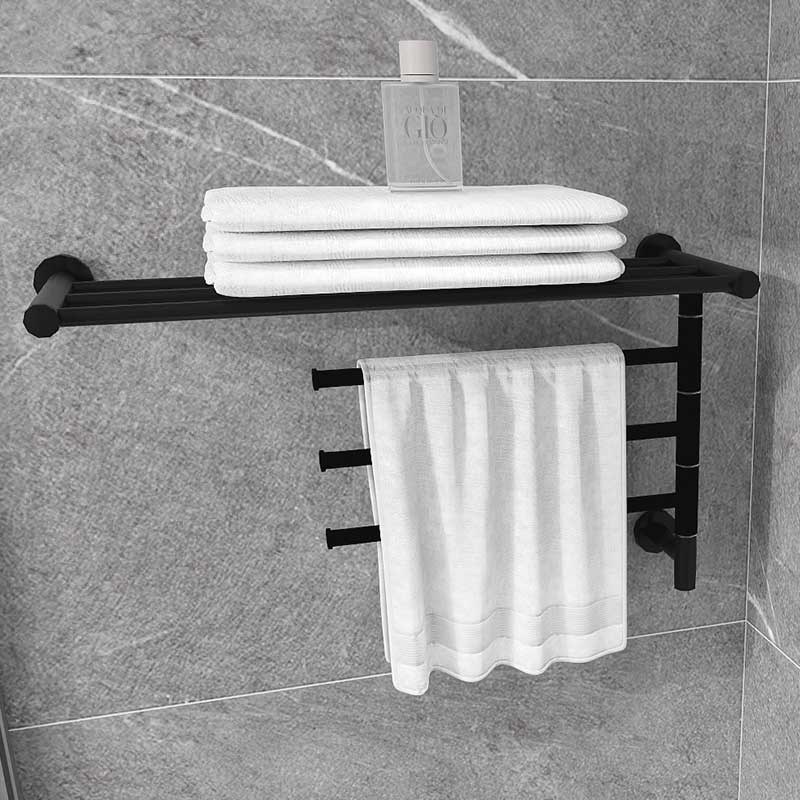How Does An Electric Towel Rail Work?
An electric towel rail is a simple but efficient appliance that uses electrical energy to warm metal bars, creating radiant and convective heat to dry towels and gently warm bathrooms. Its efficiency lies in precision design—how power converts to heat, how warmth spreads through the structure, and how control systems regulate temperature. Understanding how it works helps users operate it economically while enjoying daily comfort. Our Electric Towel Rack series applies these same principles for quick heating, even temperature, and safe operation.
1. How the Heating System Works
Power and conversion
When you switch on an electric towel rail, electricity flows to an internal heating element. This element—made of nickel-chrome alloy or ceramic resistance wire—transforms electrical energy into heat. In oil-filled models, the element warms a special heat-transfer fluid that circulates throughout the frame. In dry-element rails, the element heats the metal body directly without fluid. Both methods achieve the same goal: consistent warmth across all bars.
Heat transfer process
The heated element raises the temperature of the rail’s tubes. Metal, usually stainless steel or mild steel, conducts heat efficiently. The warmth spreads evenly through each rung and radiates outward. At the same time, air near the rail warms and rises, drawing cooler air from below. This convection flow circulates warmth through the room and helps towels dry faster by carrying moisture away.
Radiant and convective balance
Two mechanisms work together: radiation warms objects (like towels) directly, while convection moves air to dry fibers. A well-designed rail balances these forces. Too much radiation overheats one area; too much convection wastes energy. The best electric towel rails, like our Electric Towel Rack, use optimized spacing and tube thickness to distribute both types of heat evenly.
Temperature regulation
Once the rail reaches the set temperature, an integrated thermostat cuts power to the element. When the temperature drops slightly, power resumes. This on-and-off cycle—known as the duty cycle—prevents overheating and reduces electricity consumption. In a typical bathroom, the element may only run 30–50% of the time, so real power use is far less than the rated wattage.
2. The Control and Safety System
Thermostat and timer
Most electric towel rails include either a built-in thermostat or an external digital controller. The thermostat monitors surface or room temperature to maintain steady warmth. A timer allows users to program operating hours—for example, preheating before morning showers and turning off automatically afterward. Smart scheduling avoids unnecessary energy use while ensuring towels stay dry.
Duty cycle and efficiency
The duty cycle determines how long the rail draws full power. A 400W model running at 40% duty cycle averages only 160W per hour. Proper insulation, towel spacing, and moderate settings all reduce the cycle length. Many modern rails integrate adaptive start features that learn heating patterns, optimizing energy efficiency automatically.
Protection mechanisms
Safety systems include thermal cutouts, RCD (residual current device) protection, and IP-rated sealing. A thermal cutout disconnects power if the element overheats—such as when a towel covers the thermostat sensor. The IP rating (for example, IP44 or IP55) ensures the enclosure is safe against water splashes in bathroom zones. All circuits should be protected by an RCD to shut off instantly if a fault occurs, guaranteeing electrical safety in humid spaces.
Intelligent features
High-end models incorporate open-window detection, which pauses heating if sudden temperature drops suggest a window is open. Some units feature Wi-Fi or Bluetooth control, enabling users to adjust schedules remotely. These refinements keep energy use predictable and comfort consistent.
3. Design Details That Affect Performance
Material and build quality
Electric towel rails are usually made from stainless steel, aluminum, or mild steel. Stainless steel offers corrosion resistance and long life. Aluminum heats rapidly and cools quickly, perfect for short usage cycles. Mild steel provides affordability with durable powder coatings. The smoother the finish, the easier it is to clean and the more evenly it radiates heat.
Bar spacing and airflow
Proper bar spacing ensures efficient drying. Air needs room to circulate between towels. A spacing of 80–120 mm between bars allows warm air to flow upward, while wider stand-offs from the wall (about 50 mm) improve back ventilation. Without airflow, moisture lingers, and the rail runs longer to achieve the same drying effect.
Oil-filled vs. dry-element comparison
Oil-filled rails: Heat is stored in the thermal fluid, providing stable warmth and longer retention even after power stops. Ideal for continuous low-level heating.
Dry-element rails: Heat up quickly and respond instantly to timers, making them perfect for short bursts of use or smaller bathrooms.
Our Electric Towel Rack series includes both types, allowing customers to match performance to usage patterns.
Mounting and installation
Rails must be securely fixed to prevent movement when loading towels. Correct installation also affects efficiency—mounting too close to the wall restricts airflow, while too far wastes radiant energy. All models should connect through a fused spur or plug-in outlet with appropriate circuit protection. Professional installation ensures correct earthing and compliance with electrical codes.
4. Everyday Function and Energy Understanding
The working cycle in daily use
When powered on, the element heats for several minutes until the frame reaches the thermostat setpoint. The rail radiates warmth to towels, while convection currents carry moisture away. As towels dry and surface temperature rises, the thermostat cycles off. This pattern repeats throughout the day, maintaining consistent comfort with minimal power draw.
Typical energy consumption
A mid-sized 400W rail used for 3 hours daily with a 40% duty cycle consumes roughly 0.48 kWh per day, costing around $0.14/day at standard electricity rates. This efficiency makes electric towel rails economical compared to running a full central heating circuit just for towel drying.
Maintenance and longevity
Electric towel rails require little maintenance. Periodically check brackets for tightness, wipe the surface with a soft cloth, and ensure the thermostat sensor area remains unobstructed. For oil-filled versions, no refilling or bleeding is needed—the system is permanently sealed. High-quality rails typically last 10–15 years without performance loss.
Why our Electric Towel Rack stands out
Our Electric Towel Rack range integrates precision thermostats, corrosion-resistant materials, and optimized bar spacing for superior performance. Models include adjustable timers, eco-modes, and multi-surface coatings that enhance radiant efficiency. The result is a product that heats quickly, maintains uniform temperature, and runs economically throughout its lifespan.
Conclusion
So, how does an electric towel rail work? It converts electricity into controlled heat, distributed evenly through a metal frame that dries towels and warms the air. A thermostat manages the temperature cycle for consistent comfort and energy savings. Materials, spacing, and smart controls refine this process, turning a simple appliance into a daily luxury.
With our Electric Towel Rack, users enjoy fast heating, reliable safety, and long-term efficiency—proof that modern design can blend comfort, technology, and economy in one sleek bathroom solution.




